Card Counting the Red Flex Blackjack Side Bet

Red Flex Bet (RF) is a side bet for the blackjack variant “Pure 21.5 Blackjack” that is played in California card rooms. This side bet can also work as a side bet for ordinary blackjack, though I am not aware of any blackjack placements. I am also not aware of any placement outside of California card rooms. I was told that RF is fairly common in northern California card rooms, with a maximum wager of $50 to $100. There is no extra collection for RF wagers, and players can play RF on multiple spots if they are available.
RF pays based on the number of consecutive red cards the dealer draws to his hand, including his first two cards. If the dealer has a black card in his first two cards, then RF loses. Otherwise, the number of red cards that occur until either the dealer finishes his draws, or until he draws a black card, is used to determine the payout. For example, if the dealer has the initial hand 2D/3H, then draws 4D, 5H, AC, 6H (for a total of 21), then the number of red cards for the purpose of reconciling the RF bet is four (4). The black AC ended the streak of red cards.
The documentation I have includes twelve (12) different pay tables for RF. The focus of my investigation was on the following pay table, which is currently in use in several card rooms:
- Two red cards pays 2-to-1.
- Three red cards pays 3-to-1.
- Four red cards pays 8-to-1.
- Five red cards pays 50-to-1.
- Six red cards pays 100-to-1.
- Seven or more red cards pays 250-to-1.
- All others lose.
Card counting is typically much stronger with two decks than with six. However, in California, this wager is only offered on shoe games. For that reason, I only considered the six-deck version. The following table gives the combinatorial analysis for the RF bet for a six-deck shoe with the pay table given above.
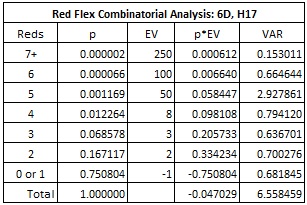
In particular note that:
- The house edge is 4.703%.
- The hit frequency is 24.920%.
- The standard deviation is 2.561.
The following table gives the effect of removal (EOR) for each card. The EOR tells the change in house edge by removing a single card of that rank from the shoe and re-computing the house edge. A positive EOR means the edge moves towards the player side if the card is removed. A negative EOR means the edge moves towards the house side if the card is removed.
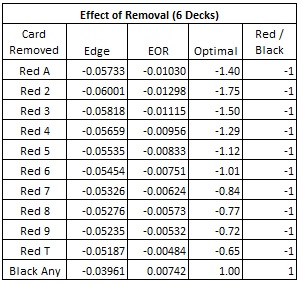
Note that a red deuce is the single most valuable card for the AP (EOR = -1.298%). If this card is dealt to the dealer’s hand, his hand gets a red card while keeping his total as low as possible. Similarly, a red ten-valued card is the least valuable red card for the dealer to be dealt (EOR = -0.484%). Removing a red deuce has nearly three times the negative effect on the edge as removing a red ten-valued card. On the other hand, it doesn’t matter which rank of black card is removed, they all have the same effect on the edge. When any black card is removed, the house edge moves towards the player-side by about 0.742%.
Based on the EOR’s, I developed and tested two card counting systems which are given in the final two columns of the table above.
System #1 is the “optimal” system. I simply divided each entry in the EOR column by the value 0.00742 (the EOR for any black card). It is not feasible to use the optimal system at the table, but it is useful to analyze it as it gives an upper bound for the profit available by card counting RF.
System #2 is the “red/black” system. It is intuitively the most obvious and easy system to use. Simply, the AP is happy when black cards leave the shoe (+1) and sad when red cards leave the shoe (-1).
To analyze these two systems, I ran one hundred million (100,000,000) six-deck shoes each, with the cut card placed at 260 cards (52 cards from the end), for each system. The following table summarizes the results of these simulations:
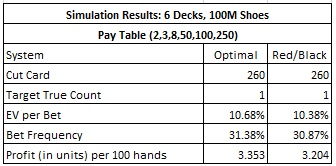
Note that the red/black system returns about 95.6% of the profit per 100 hands that the optimal system returns. The red/black system is sufficiently strong that there is no need to look for a multi-level card counting system that performs better.
These numbers indicate an extreme vulnerability to advantage play. If the AP uses the red/black system on a game that is moving at a pace of 100 rounds per hour, and the AP makes a $100 wager on RF whenever he has the edge, then the AP can earn about $320 per hour. This return will easily overcome any fee collection on the main game. The AP will make a RF wager on about 31% of the hands, and his average edge over the house when he makes an RF wager will be about 10.4%.
The following graph shows the player’s edge, using the red/black system, as a function of the true count. The player’s edge grows very fast compared to the ordinary blackjack card counter. For example, when the true count is +18 or higher, the AP has an edge of more than 100% over the house. The break-even true count is +1.
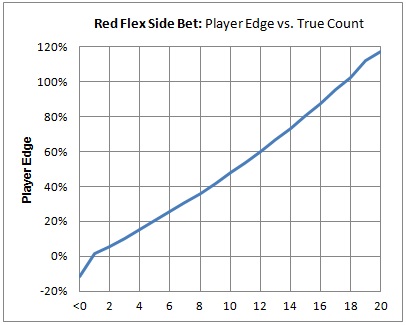
The most common approach to game protection is to reduce penetration between shuffles. The following table shows the card counting statistics for using the red/black system against RF, for various cut-card placements from one-half deck to three decks. These results show that even with a shallow cut-card placement at 3 decks (midway in the shoe), RF still has a very high vulnerability to card counting:
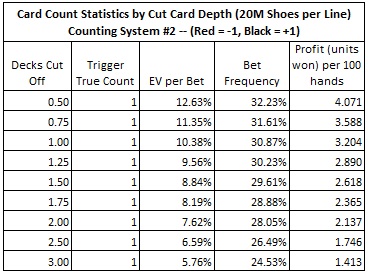
There are two other pay tables that I considered. First, I was told by a corporation that a card room they bank at has a pay table that adds a pay for 8 or more red cards.
- Two red cards pays 2-to-1.
- Three red cards pays 3-to-1.
- Four red cards pays 8-to-1.
- Five red cards pays 50-to-1.
- Six red cards pays 100-to-1.
- Seven red cards pays 200-to-1.
- Eight or more red cards pays 300-to-1.
- All others lose.
The following table gives the combinatorial analysis for the RF bet for a six-deck shoe with the pay table given above:
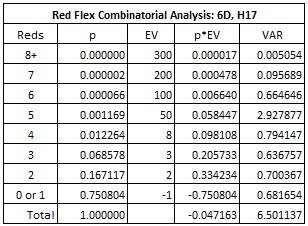
The following table summarizes the card counting statistics for using the red/black count against the pay table given above:
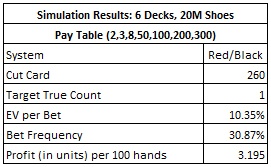
These numbers indicate an extreme vulnerability to advantage play. The results are very similar to those for the (2,3,8,50,100,250) pay table.
The other pay table I considered is the one posted on the Wizard of Odds website under its section on the Red Flex bet.
- Two red cards pays 1-to-1.
- Three red cards pays 5-to-1.
- Four red cards pays 10-to-1.
- Five red cards pays 50-to-1.
- Six red cards pays 100-to-1.
- Seven or more red cards pays 200-to-1.
- All others lose.
The following table gives the combinatorial analysis for the RF bet for a six-deck shoe with the pay table given above:
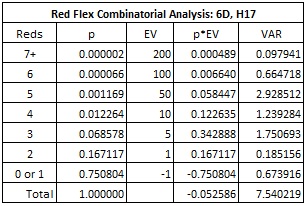
The following table summarizes the card counting statistics for using the red/black count against the pay table given above:
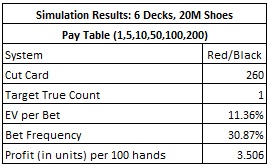
These results show that RF is more vulnerable to card counting with the (1,5,10,50,100,200) pay table than with the (2,3,8,50,100,250) pay table, even though the former has a higher baseline house edge than the latter.
For the (1,5,10,50,100,200) pay table, if the AP uses the red/black system on a game that is moving at a pace of 100 rounds per hour, and the AP makes a $100 wager on RF whenever he has the edge, then the AP can earn about $351 per hour. He will make a RF wager on about 31% of the hands, and his average edge over the house when he makes an RF wager will be about 11.4%.
Usually at this point in a blog post analyzing advantage play I would give game protection suggestions. In the case of RF, its extreme vulnerability means extreme measures.
Here are my suggestions for the corporation:
- Each player/banker should learn the basics of card counting.
- Watch for wagers at table-maximum after a few rounds.
- Watch for players who spread to table-maximum wagers on several hands.
- Watch for players who want to wager more on RF than on the main game.
- Watch for team play.
The main problem, though, is that the corporation usually doesn’t have the ability to do anything to back off a player they may identify as a counter. The corporation will know it is getting beat, but without the power to take action, that knowledge will do little good. Card rooms have to realize that they are offering highly vulnerable games, and they have to be willing to do something to protect their games. The relationship between the card room and the corporation must be one of mutual support. The corporation supports the card room by banking its games, paying the collections and risking its own money. The card room can support the corporation by taking actions to mitigate advantage play.
Here are my suggestions for card room management:
- If an AP is identified and verified, back him off!
- Use a pay table that increases the house edge to at least 10%.
- Place the cut card at 2.5 decks or above if card counting RF is observed by the corporation.
- Consider only having RF on games that use a continuous shuffle machine.
- Love your corporation!


